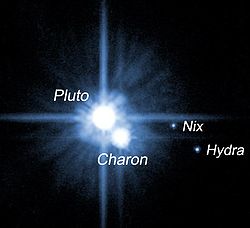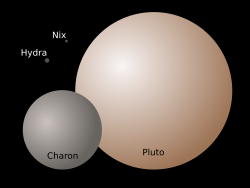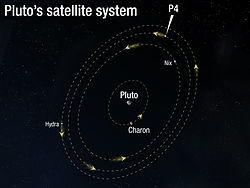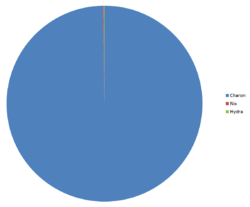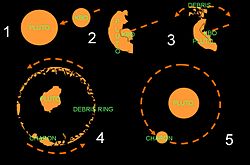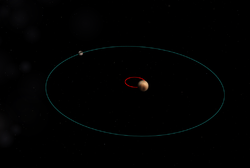- Moons of Pluto
-
Pluto has four known moons. The largest, Charon, is proportionally larger, compared to its primary, than any other satellite of a known planet or dwarf planet in the Solar System. The other moons, Nix, Hydra, and S/2011 P 1 ("P4")[1] are much smaller.[2] The team that discovered S/2011 P 1 also found possible evidence of a couple of even fainter moons, but this needs more study to be confirmed.[3]
Contents
History
The innermost moon, Charon, was discovered by James Christy on June 22, 1978, nearly half a century after Pluto. Two outer moons were imaged by the Hubble Space Telescope Pluto Companion Search Team in May 2005, and precovered from Hubble images taken in June 2002. With the orbits confirmed, the moons have been given definitive names: Hydra (Pluto III, formerly S/2005 P 1) and Nix (Pluto II, formerly S/2005 P 2). The names were chosen in part because the initials (NH) allude to the New Horizons mission.[4] Further Hubble observations were made in February and March 2006. The possibility of rings created by impacts on the smaller moons will be investigated by the New Horizons probe. The fourth moon was announced in July 2011[1].
Characteristics
The Plutonian system is highly compact: The four known satellites orbit within the inner 3% of the region where prograde orbits would be stable.
Pluto and Charon have been called a double planet because Charon is larger compared to Pluto (half its diameter and an eighth its mass) than any other moon is to a planet or dwarf planet; indeed, Charon is massive enough that, despite their proximity, Pluto orbits the system's barycenter at a point outside its surface.[5] Charon and Pluto are also tidally locked, so that they always present the same face toward each other.
Following Buie and Grundy's recent re-calculations taking into account older images, the orbits of the moons are confirmed to be circular and coplanar, with inclinations differing less than 0.4° and eccentricities less than 0.005. The diagram on the left shows the view from the axis of the moons' orbits (declination 0°, right ascension 133°), aligned with the HST diagram above it. As seen from Earth, these circular orbits appear foreshortened into ellipses depending on Pluto's position.[6]
When discovered, Hydra was somewhat brighter than Nix, and therefore thought to be larger by 20%, but follow-up observations found them to be nearly identical. It is likely that the change in brightness is due to the light curve of Hydra, but whether this is due to an irregular shape or to a variation in surface brightness (albedo) is unknown. The diameters of objects can be estimated from their assumed albedos; the estimates above correspond to a 35% albedo like Charon, but the moons could be as large as 130 km if they have the 4% albedo of the darkest KBOs. However, given their color and suspected chemical similarities to Charon, it is likely that their albedos are similar as well and that the diameters are closer to the lower estimates.
Formation and resonances
It is suspected that the Plutonian satellite system was created by a massive collision, similar to the "big whack" believed to have created the Earth's Moon.[7][8] In both cases it may be that the high angular momenta of the moons can only be explained by such a scenario. The nearly circular orbits of the smaller moons suggests that they were also formed in this collision, rather than being captured Kuiper Belt objects. This and their near orbital resonances with Charon (see below) suggest that they formed even closer to Pluto than they are at present, and that they migrated outward as Charon achieved its current orbit. If Hydra and Nix turn out to be tidally locked, as Charon is, that will settle the issue, as tidal forces are insufficient to damp their rotations in their present orbits. The color of each is a lunar grey like Charon,[9] which is consistent with a common origin. Their difference in color from Pluto, one of the reddest bodies in the Solar System due to the effects of sunlight on the nitrogen and methane ices of its surface, may be due to a loss of such volatiles during the impact or subsequent coalescence, leaving the surfaces of the moons dominated by water ice. Such an impact would be expected to create additional debris (more moons), but these must be relatively small to have avoided detection by Hubble. It is possible that there are also undiscovered irregular satellites, which are captured Kuiper Belt objects.
Nix, S/2011 P 1 and Hydra are very close to a 1:4:5:6 orbital resonance with the Charon-Pluto orbital period: Nix is within 2.7% of resonance, S/2011 P 1 is apparently within 0.6%, while Hydra is within 0.3%, though none appear to be in an exact resonance. It may be that these orbits originated as forced resonances when Charon was tidally boosted into its current geosynchronous orbit, and then released from resonance as Charon's orbital eccentricity was tidally damped. Today the Pluto–Charon pair continue to produce strong tidal forces, with the gravitational field at the outer moons varying by 15% peak to peak. At the lower estimated size range, Nix should have no significant precession, while Hydra should have a precession period of 15 years. However, at their maximum projected masses (assuming an albedo of 4%), the two moons may be in a 3:2 orbital resonance with each other, with libration periods of 400 to 450 days, though this may already be ruled out by the low eccentricity of Charon.[10] Thus accurate orbital data can help resolve the sizes of these moons.
However, it was recently calculated that a resonance with Charon could boost either Nix or Hydra into its current orbit, but not both: boosting Hydra would have required a near-zero Charonian eccentricity of 0.024, while boosting Nix would have required a larger eccentricity of at least 0.05. This suggests that Nix and Hydra were instead captured and migrated inward until they were trapped in resonance with Charon.[11]
Table
The Plutonian moons are listed here by orbital period, from shortest to longest. Moons massive enough for their surfaces to have collapsed into a spheroid are highlighted in light purple. Pluto has been added for comparison, for it orbits a point outside itself. The team that discovered S/2011 P 1 also found possible evidence of a couple of even fainter moons, but this needs more study to be confirmed.[3]
Notes:
Satellite data from Buie & Grundy; a, i, e updated with JPL (site updated 2008 Aug 25). Pluto data from D. R. Williams (September 7, 2006). "Pluto Fact Sheet". NASA. http://nssdc.gsfc.nasa.gov/planetary/factsheet/plutofact.html. Retrieved 2007-03-24..
Orbital eccentricity and inclination of Pluto and Charon are equal since they refer to the same two-body problem (the gravitational influence of the minor satellites Nix and Hydra is neglected here).
Image of Charon courtesy of Marc W. Buie/Lowell Observatory.[12]Name
(pronunciation)Image Mean diameter
(km)Mass (×1021 kg) Semi-major
axis (km)Orbital period
(days)Eccentricity Inclination
(to Pluto's equator)Discovery
datePluto 2390 13.05 ± 0.07 2 035* 6.387 230 0.0022 0.001° 1930 Pluto I Charon /ˈʃærən/,[13]
/ˈkɛərən/1207 ± 3 1.52 ± 0.06 17 536 ± 3* 6.387 230 0.0022 0.001° 1978 Pluto II Nix /ˈnɪks/ 46–137 < 0.002 48 708 24.856 ± 0.001 0.0030 0.195° 2005 Pluto IV S/2011 P 1 13–34 ? ~59,000[14] 32.1[14] ~0[14] ? 2011 Pluto III Hydra /ˈhaɪdrə/ 61–167 < 0.002 64 749 38.206 ± 0.001 0.0051 0.212° 2005 * The maximum distance between the centers of Pluto and Charon are the sums of their semi-major axes, 19,571 ± 4 km.
Notes
- ^ a b "Fourth Moon Adds to Pluto's Appeal". http://pluto.jhuapl.edu/news_center/news/20110720.php?utm_source=feedburner&utm_medium=feed&utm_campaign=Feed%3A+NewHorizonsHeadlines+%28New+Horizons+News+Feed%29. Retrieved 2011-07-20.
- ^ Schilling, Govert (20 June 2006). "Pluto's Twins Get Their Names". ScienceNOW Daily News. http://sciencenow.sciencemag.org/cgi/content/full/2006/620/1. Retrieved 2006-06-21.
- ^ a b Is the Pluto System Dangerous? – New Horizons
- ^ comcast.net
- ^ See "P1P2_motion.avi" (AVI). http://wwwsa.boulder.swri.edu/P1P2_motion.avi. and barycenter for animations
- ^ "Orbits of 4 Bodies in Pluto System about Barycenter as Seen from Earth". Hubblesite. http://hubblesite.org/newscenter/newsdesk/archive/releases/2005/19/image/h. Retrieved 2006-06-21.
- ^ Canup, R. M. (2005-01-08). "A Giant Impact Origin of Pluto-Charon". Science 307 (5709): 546–550. Bibcode 2005Sci...307..546C. doi:10.1126/science.1106818. PMID 15681378. http://www.sciencemag.org/content/307/5709/546.abstract. Retrieved 2011-07-20.
- ^ Stern, S. A.; Weaver, H. A.; Steff, A. J.; Mutchler, M. J.; Merline, W. J.; Buie, M. W.; Young, E. F.; Young, L. A.; Spencer, J. R. (2006-02-23). "A giant impact origin for Pluto’s small moons and satellite multiplicity in the Kuiper belt". Nature 439 (7079): 946–948. Bibcode 2006Natur.439..946S. doi:10.1038/nature04548. PMID 16495992. http://ns1.plutoportal.net/~layoung/eprint/Stern2006plutosat.pdf. Retrieved 2011-07-20.
- ^ "Hubble's Latest Look at Pluto's Moons Supports a Common Birth". Hubblesite. http://hubblesite.org/newscenter/newsdesk/archive/releases/2006/15/. Retrieved 2006-06-21.
- ^ Lee, Man Hoi; S. J. Peale (2006). "On the Orbits and Masses of the Satellites of the Pluto–Charon System". arXiv:astro-ph/0603214 [astro-ph].
- ^ Y. Lithwick & Y. Wu; Wu (2007). "On the Origin of Pluto's Minor Moons, Nix and Hydra". American Astronomical Society, DDA meeting #38, #3.05 38. Bibcode 2007DDA....38.0305L.
- ^ Buie: Mapping the surface of Pluto and Charon
- ^ Many astronomers use this idiosyncratic pronunciation, rather than the classical /ˈkɛərɒn/, but both are acceptable.
- ^ a b c Lakdawalla, E. (2011-07-20). "A fourth moon for Pluto". Planetary Society weblog. The Planetary Society. http://www.planetary.org/blog/article/00003107/. Retrieved 2011-07-20.
References
- S.A. Stern, H.A. Weaver, A.J. Steffl, M.J. Mutchler, W.J. Merline, M.W. Buie, E.F. Young, L.A. Young, & J.R. Spencer (2006), Characteristics and Origin of the Quadruple System at Pluto, Nature, submitted (preprint)
- Steffl A.J., Mutchler M.J., Weaver H.A., Stern S.A., Durda D.D., Terrell D., Merline W.J., Young L.A., Young E.F., Buie M.W., Spencer J.R. (2005), New Constraints on Additional Satellites of the Pluto System, Astronomical Journal, submitted (preprint)
- Buie M.W., Grundy W.M., Young, E.F., Young L.A., Stern S.A. (2005), Orbits and photometry of Pluto's satellites: Charon, S/2005 P1 and S/2005 P2, submitted (preprint)
- IAU Circular No. 8625 describing the discovery
- IAU Circular No. 8686 which reports a much more neutral color for P2
- IAU Circular No. 8723 announcing the names of Nix and Hydra
- Background Information Regarding Our Two Newly Discovered Satellites of Pluto – The discoverers' website
External links
- Animation of the Plutonian system
- Hubble Spots Possible New Moons Around Pluto (NASA)
- Two More Moons Discovered Orbiting Pluto (SPACE.com)
Moons of dwarf planets Pluto Characteristics - Atmosphere
- Moons

Discovery Exploration 20th-century classification 21st-century classification Other topics Natural satellites of the Solar System Planetary satellites 
Other satellite systems - Asteroid satellites
- Plutonian
- Eridian
- Haumean
Largest satellites - Inner satellites
- Trojans
- Irregulars
- List
- Timeline of discovery
- Naming
The Solar System  Categories:
Categories:- Pluto's moons
- Lists of moons
Wikimedia Foundation. 2010.

